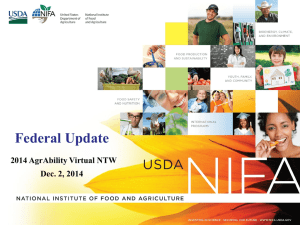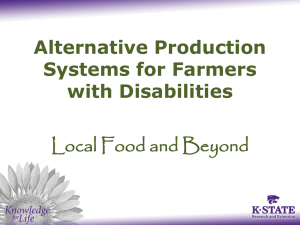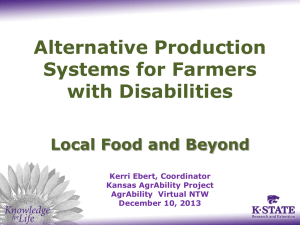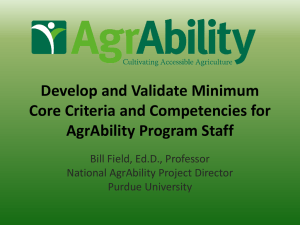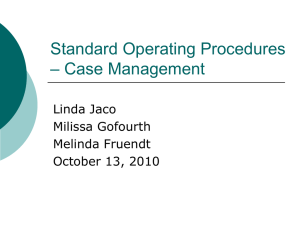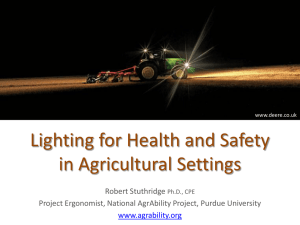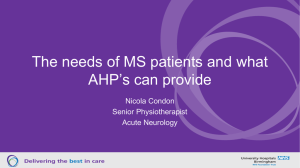What Implications Can We Draw from These QOL Results?
advertisement
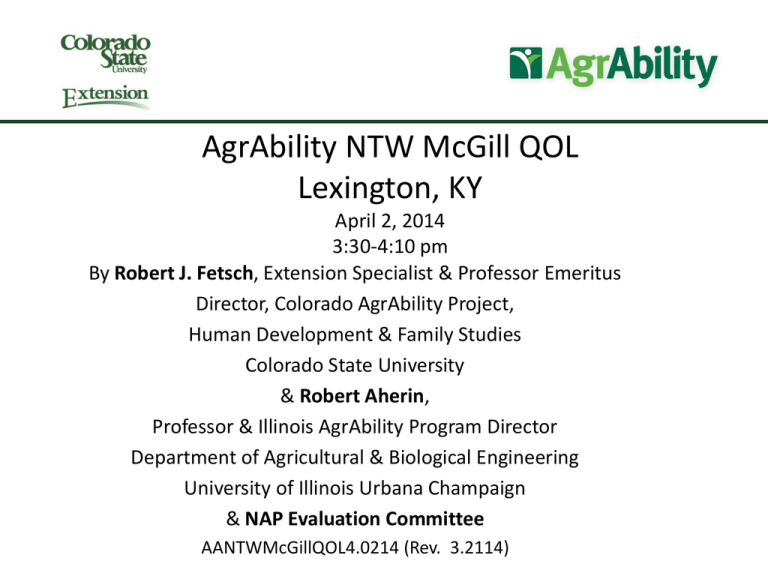
AgrAbility NTW McGill QOL Lexington, KY April 2, 2014 3:30-4:10 pm By Robert J. Fetsch, Extension Specialist & Professor Emeritus Director, Colorado AgrAbility Project, Human Development & Family Studies Colorado State University & Robert Aherin, Professor & Illinois AgrAbility Program Director Department of Agricultural & Biological Engineering University of Illinois Urbana Champaign & NAP Evaluation Committee AANTWMcGillQOL4.0214 (Rev. 3.2114) What Can We learn from Our 493 New Clients with McGill QOL Pre-Survey Data? By Robert J. Fetsch (CSU), Robert Aherin (UIL), Vicki Janisch (UW), Sheila Simmons (KU), Candy Leathers (CSU/Goodwill Denver), Diana Sargent (OSU), Kirk Ballin (ESVA), Sharry Nielsen (UN), Inetta Fluharty (WVU), Rick Peterson (TAMU), Leilani Carlson (UME), Mary Hildebrand (ECU), Toby Woodson (UAR), & Danielle Jackman (CSU) Our AgrAbility Mission “The AgrAbility Mission is to enhance and protect quality of life and preserve livelihoods. It’s about supporting and promoting growth and independence. Ultimately it’s about hope.” Source: National AgrAbility Project. (2011). It’s about hope [DVD]. Author: Purdue University. NAPEC Produced Results • Published two refereed journal articles and submitted another. – Christen, C. T., & Fetsch, R. J. (2008). Colorado AgrAbility: Enhancing the effectiveness of outreach efforts targeting farmers and ranchers with disabilities. Journal of Applied Communication, 92(1&2), 1-12. – Jackman, D. M., Fetsch, R. J., & Collins, C. L. (2014). Quality of life and independent living and working levels of farmers and ranchers with disabilities. Manuscript submitted for publication. – Meyer, R. H., & Fetsch, R. J. (2006). National AgrAbility Project impact on farmers and ranchers with disabilities. Journal of Agricultural Safety and Health, 12(4), 275-291. History of National AgrAbility Project Evaluation Committee • Early 2006—Kathryn Pereira, Evaluation Specialist NAP U of WI, invited all SRAP’s to join in an AgrAbility evaluation study. • The National AgrAbility Evaluation Committee (NAPEC) met approximately bi-monthly (2007Present) via teleconference/face-to-face (N = 6-25 participants/meeting). How many SRAPs are collecting QOL and ILOS data from their new clients? History of National AgrAbility Evaluation Committee • As of 3/30/14, 16/24 SRAPs (66.7%) are on the NAP Evaluation Committee (AR, CO, KS, ME, MN, MO, NC, NE, OH, OK, PA, TX, UT, VA, WI, & WV). History of National AgrAbility Evaluation Committee • Who is an AgrAbility Client? An AgrAbility client is an individual with a disability engaged in production agriculture as an owner/operator, family member, or employee who has received professional services from AgrAbility project staff during an on-site visit. Today Let’s Answer 5 Questions. • 5 Questions: – When they say “Yes” to AgrAbility, what are our clients’ QOL & ILW levels? – How do QOL & ILW levels differ by primary disability? – How do our QOL levels compare with Fetzer’s (2010) non-intervention group? – What’s ILW’s role in predicting QOL level? – What implications can we draw from these results? History of National AgrAbility Evaluation Committee • Eleven SRAP’s conducted a 6.5-year study to answer the questions. • McGill QOL—AR, CO, KS, ME, NE, NC, OK, TX, VA, WI, & WV • We collected 493 pre-surveys with a 60.4% response rate. Measures Used in 11-State Study • McGill Quality of Life (QOL) Survey & AgrAbility Independent Living & Working Survey (ILW) • NAP Demographic Data McGill Quality of Life Scale • Is short with only 17 items. • Is a positive, strength-focused scale rather than focused on lists of physical problems. • Measures multiple domains—physical, psychological well-being, support, and experiential well-being domains. • Fits well with our mission to give people hope. Protocol • Procedure—11 SRAPs mailed each new client the Pre-Survey, a cover letter, McGill Pre-Survey, and a stamped, self-addressed envelope with an invitation to complete and return the Pre-Survey. Protocol • Participants were given the choice of completing the survey themselves or of having the items read aloud by the AgrAbility team member. No one was coerced to complete and return their surveys. We Have 3 Objectives Today • To learn who our clients are when they say “Yes” to AgrAbility. • To learn which disabilities are associated with the highest and lowest QOL and ILW levels. • To learn how your SRAP can join us in determining AgrAbility’s effectiveness. Who Were the Participants in the Study (N = 493)? • 75.1% were male; 20.1% were female; 4.9% N.R. • 74.2% were Operators/Owners. • 64.9% were Full-Time. • M Age was 55.9 (SD = 13.8); M Age in U.S. was 57.1 in 2007.* • Education level ? • Ethnicity ? • Total household income ? • No. days off farm ? • Veteran ? *Source: Retrieved April 27, 2007 from http://nass.usda.gov/census/ Who Were the Participants in the Study? (N = 474) • Primary Agricultural Operation was… – 32.9% dairy – 25.5% livestock – 22.6% field or grain – 19.0% other What Are Clients’ QOL Levels When They Ask for AgrAbility Assistance? • QOL levels M = 5.50 (SD = 1.63; N = 448; Range = 0-10). Results • On QOL levels, males’ and females’ scores were about the same. • Middle-aged clients’ QOL levels were significantly lower than those of younger and elder clients. QOL Levels by Age Group What Were Clients’ Primary Disabilities (N = 493)? • Back injury 83 16.8% • Joint injury 69 14.0% • Arthritis 48 9.7% • Orthopedic injury 35 7.1% • Visual impairment 20 4.1% • Leg & foot amputation 19 3.9% • Cardiovascular disease 19 3.9% • Stroke 17 3.4% • Spinal paraplegia & quadriplegia 16 3.2% • Other 167 33.9% QOL Levels by Disability • On QOL levels by disability, what do you think? Do you think they’re different by disability? How? Do QOL Levels Differ by Disability? • On QOL levels by disability, there was no difference by disability. Their QOL levels were all about the same. What Implications Can We Draw from These QOL Results? What Implications Can We Draw from These QOL Results? • Regardless of disability, our clients all begin their work with us with about the same QOL level. • So we want to work hard with each of them to assist them to modify their machinery, home and workspaces to continue to live at home. How Do Our QOL Results Compare with Fetzer’s (2010)? Why Do You Think Fetzer’s average QOL Level Was Higher than Ours? What Implications Can We Draw from These QOL Results? How Do Our QOL Results Compare with Fetzer’s (2010)? • Maybe PA farmers and ranchers are happier and have higher QOL levels. • Maybe history intervened. Fetzer’s data was collected prior to the Great Recession; ours was collected after the Great Recession. • Perhaps the breadth of the sample could account for the difference—Fetzer’s was one state; NAP E. C.’s was 11 states. • What else? What Implications Can We Draw from These QOL Results? • Both samples rated support and experiential wellbeing highest. • Given their high level of support, let’s encourage our clients to continue to draw on family members and agrifamily members for support. • Families in tough times do better when they use their support systems. What Are Our Clients’ ILW Levels When They Ask for AgrAbility? • ILW levels M = 18.67 (SD = 5.34; N = 450; Range = 0-30) • With ILW levels, males’ ILW levels were statistically significantly higher. Males’ M = 19.26; Females’ M = 16.52. What Are Our Clients’ ILW Levels When They Ask for AgrAbility? ILW Levels by Age Group • ILW levels M = 18.67 (SD = 5.34; N = 450) • With ILW levels, middle-age clients scored significantly higher than the young group. • Young (18-44) M = 17.37; Middle (45-65) M = 19.32; Older (>65) M = 18.76 ILW Levels by Age Group What Implications Can We Draw from These ILW Results? • We need to be sure with middle age group to focus on providing AT, because it will help improve their QOL levels. • With female clients, let’s do a better job with listening to their needs and goals and respond to their AT needs well, because it will help improve their QOL levels. ILW Levels by Disability • On ILW levels by disability, what do you think? Do you think they’d be different by disability? How? Do ILW Levels Differ by Disability? • On ILW levels by disability, there were differences by disability. Independent Living & Working Survey (ILW) • I am able to… – Complete chores on my farm/ranch. – Operate machinery. – Manage my farm/ranch. – Access workspaces on my farm/ranch. – Live in my home on the farm/ranch – Change or modify my machinery in order to accommodate my needs. Do ILW Levels Differ by Disability? • • • • • • • • • • Joint injury Arthritis Back injury Orthopedic injury Cardiovascular disease Other infrequent disabilities Stroke Leg & foot amputation Visual impairment Spinal paraplegia & quadriplegia 21.06 19.96 19.48 19.29 18.78 17.90 17.29 15.95 15.30 15.06 67 45 77 34 18 137 17 19 20 16 13.6% 9.1% 15.6% 6.9% 3.7% 27.8% 13.4% 3.9% 4.1% 3.2% What Implications Can We Draw from These ILW Results? ILW Levels Differ by Disability • Those with spinal paraplegia and quadriplegia had ILW total scores significantly lower than those with back injury, arthritis, and joint injury. • Those with visual impairments had significantly lower ILW total scores than those with arthritis and joint injury. • Those with leg and foot amputations had significantly lower ILW total scores than those with joint injuries. • What else? What’s the Role of ILW in Predicting QOL Levels? • We used multiple linear regression to find a model that best predicts QOL levels to see whether age group and ILW scores improve the prediction of QOL levels. What’s the Role of ILW in Predicting QOL Levels? • The combination of age group and ILW levels predicts 16.3% of QOL levels. We Have 3 Objectives Today • To learn who our clients are when they say “Yes” to AgrAbility. • To learn which disabilities are associated with the highest and lowest QOL and ILW levels. • To learn how your SRAP can join us in determining AgrAbility’s effectiveness. Currently unfunded Control SRAPs? Please join us! Why Join Us? 1. Document your project’s effectiveness at increasing QOL and ILOS. 2. Enhance your chances of receiving funding next time with empirical evidence of your SRAP’s quality and effectiveness. 3. Increase your chances for outside funding by demonstrating your accountability. 4. Contribute to AgrAbility’s Mission. Remember Our AgrAbility Mission “The AgrAbility Mission is to enhance and protect quality of life and preserve livelihoods. It’s about supporting and promoting growth and independence. Ultimately it’s about hope.” Source: National AgrAbility Project. (2011). It’s about hope [DVD]. Author: Purdue University. Won’t You Join Us? Here’s how: 1. Send an email to robert.fetsch@colostate.edu. 2. Seek IRB approval from your Land-Grant University. 3. Study and use the same protocol. 4. Adapt CO to __ on pp. 1-2 & mail. 5. Enter your data into an Excel file that we will provide, proof perfectly & email to me. McGill Pre- Post-Survey Changes (Total Score) 10 9 8 7 6 5 4 3 2 1 0 MQOL Total Score (N=104)*** Pre-Survey Post-Survey AgrAbility ILW Changes (Total Score) 25 20 15 ILOS Total Score (N=124)*** 10 5 0 Pre-Survey Post-Survey These results look promising, BUT… How do we know these results are not due to something other than our AgrAbility services? “Good News” • AgrAbility is among the 45 federally funded programs that supported employment for people with disabilities in fiscal year 2010. • AgrAbility is among the 10/45 programs with a review or study to evaluate the program’s effectiveness. Source: U.S. Government Accounting Office. (2012). Employment for people with disabilities; Little is known about the effectiveness of fragmented and overlapping programs (GAO Publication No. 12-677). Washington, DC. (p. i). “Good News” • “…The Department of Agriculture’s AgrAbility program conducted a review of its activities between 1991 and 2011 and found that 11,000 clients had been served, and that 88 percent of those clients continued to be engaged in farm or ranch activities.” Source: U.S. Government Accounting Office. (2012). Employment for people with disabilities; Little is known about the effectiveness of fragmented and overlapping programs (GAO Publication No. 12-677). Washington, DC. (p. 27). “Bad News” • “However, this study did not determine whether other factors may have contributed to participants’ positive outcomes.” • “No impact study.” Source: U.S. Government Accounting Office. (2012). Employment for people with disabilities; Little is known about the effectiveness of fragmented and overlapping programs (GAO Publication No. 12-677). Washington, DC. (pp. 27, 80). The Best Way to Know Is… • To assign all of our new clients randomly to – Our Experimental Group that received onsite visits and AgrAbility information, education, and service OR to – Our Control Group that does not. Another More Practical Way to Know Is… • To compare two groups’ PretestPosttest QOL & ILW levels – 200 Experimental Group participants who complete matched pretest- and posttestsurveys. – 100 Control Group participants who complete matched pretest- and posttest-surveys. Here’s Where We Are Now… • We now have our Experimental Group with 135/200 matched pretestposttest surveys. • What we need now is a Control Group with 100 matched pretest-posttest surveys. NAP UIUC CSUE Let’s Turn to Bob Aherin for an Update on: • Where he and Chip are with the Control Group at UIUC and • How we can assist their efforts with collecting data for the Control Group. Control Group (N = 100) • Cannot be receiving any type of AgrAbility program services or onsite visits regardless of whether they are in USDA funded or Affiliate States. Where do we find 100 ranchers and farmers for the Control Group? 1. 2. Non-funded AgrAbility Affiliate States previously funded, but not currently funded to provide AgrAbility services, e.g. IA, ID, IL, MI, MT, and PA. Farmers and ranchers with disabilities who call NAP’s 1-800-825-4264 for information from non-funded states. Where do we find 100 ranchers and farmers for the Control Group? 3. Ranchers and farmers with disabilities who call in to currently funded SRAP’s but who decide not to become clients at this time. 4. National Association of County Ag Agents (N = c. 3,000 members). 5. Fingerlake, NY Goodwill? 6. Where else? Currently unfunded Control SRAPs? Please join us! Chip Petrea repetrea@illinois.edu Bob Aherin raherin@illinois.edu Thank you very much! AgrAbility across the U.S. (source: National AgrAbility Project) How Reliable Are the Subscales? • A common measure of reliability is Cronbach’s alpha. • • • • • • Subscale Physical Symptoms Psychological WB Experiential WB Support MQOL Total Pre .59 .90 .92 .82 .79 Post .85 .93 .93 .83 .87

